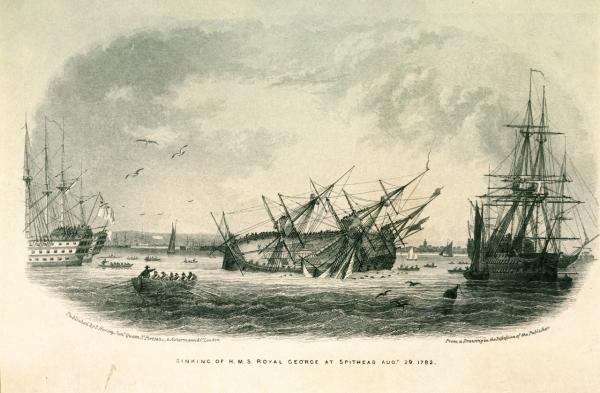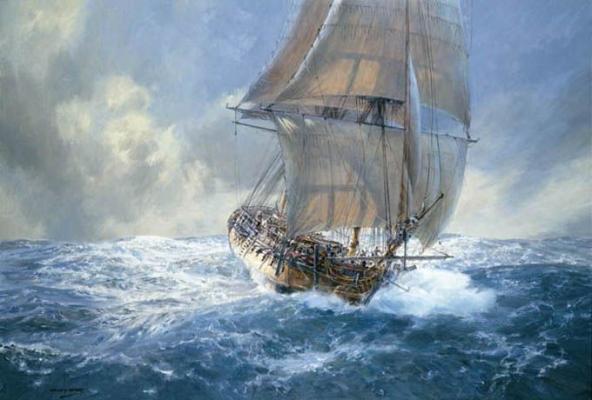-
Posts
28 -
Joined
-
Last visited
-
This practice seems quite common in 19 century. Googling RN ironclads, I can find this feature on virtually every photograph. Again, this points to the connection with harbor work, since technology back then only permitts static photoshot.
-
At last, this painting of Lord Anson's arrival at Spithead with Prizes After May 3 1747 Cape Finisterre Action by John Christian Schetky (1778-1875), shows unequivocally the bights as the fall of the yardarm tackle, though this is not quite seaman like...
-
Once again, I come across the lovely bight...
-
 cardely reacted to a post in a topic:
Question about bolt ropes
cardely reacted to a post in a topic:
Question about bolt ropes
-
 CaptainSteve reacted to a post in a topic:
Question about bolt ropes
CaptainSteve reacted to a post in a topic:
Question about bolt ropes
-
According to Steel, cringles of the head earings are formed by the surplus leech rope turn back and spliced into itself.
-
On the real ship, the leech & foot is encircled by one boltrope (the portion along the leech is called the leechrope, so is the "footrope"), leaving the head to be lined by a headrope of smaller circumference than the leech+foot rope. The headcringle is formed by splicing the two together, though the specific method of splcing, I cannot recall...
-
My guess is: this "waist belt" is improvized from other ropes, for example, the T'gllant halyard
-
Harland said this is not retained ever since the introduction of reefing, since the leechline will have less and less advantageous lead with each reef. But on the other hand, he did mention the "old" method of furling topsail as a "T" is followed well into 18 century. However, Harland also told that the throat of the T is formed by canvas restricted by the leechline. Both points can be verified by many comteporary paintings, when setting topsail, there's no leechline, while it is furled in T.
-
 GLakie reacted to a post in a topic:
Runner Pendants
GLakie reacted to a post in a topic:
Runner Pendants
-
Johnh and GLakie, Many thanks, I'm concerning the real ship only. The last illustration posed by Johnh has shown clearly what I need. Actually, I am looking for necessary details for my planned technical fiction (in Chinese) on seamanship, construction and fighting tactics of sailing men-o-war . In China, there's scarsely any serious work on Western fighting sails, despite a recent heating-up of this topic, by virtue of foreign games and series. The games and series seem to care nothing about the historical reality, while errors are frequently made in the seemingly professional ship- modeling in China. So it is necessary to let more lovers of sailing warships to tuch the hisrotical truth. But to avoid composing a boring technical note, I choose to write a series of short fictions around real or fancied figures
-
Anyone know the exact way to rig the mast tackle in tightening up the deadeye lanyards? It seems most sources leave this detail to the readers' guesswork... Would the lanyard be round-seized with the fall of the tackle?
-
Hi, Force 9, I'm a littile confused... Do you mean "burton", then following your description, it seems before lower shrouds are set taut, the topmast must already be in position. Is this the standard sequence of assemblying the mast... (I really haven't come across any authority explaining plaintly this point)? Or perhas it is just the fore or main tackles you are talking about...
-
Canute, It looks like my guess may actually hold some ground. It is known the yard arm tackles are rigged, together with burton tackles, to shift out boats I will find out the exact way of rigging yard arm tackles to "out boats" and back to my topic later.
-
Oops, I mistake your rank for name...(the bar with your name incidentlly scrolled out of the screen...) Maybe the artists don't have a good knowledge of the trade, so merely have illustrated what they have seen in their own understanding.
-
Hi moderator: On this I cannnot fully agree... In fact, the first drawing is from National Maritime Museum's booklet of ship history, according to the accampanying text, the two are east-Indianmen firing salute to the barge in the foreground, while entering their mooring. The second clearly depicts an RN 74's using flag signal to identify a frigate to the right. With the lower guns not ran out, the British seem not to expect an all-out confrontation... The last is Nelson's in-shore squadron blockading Cadiz, in this it may be expected the ships are kept ready for action.
About us
Modelshipworld - Advancing Ship Modeling through Research
SSL Secured
Your security is important for us so this Website is SSL-Secured
NRG Mailing Address
Nautical Research Guild
237 South Lincoln Street
Westmont IL, 60559-1917
Model Ship World ® and the MSW logo are Registered Trademarks, and belong to the Nautical Research Guild (United States Patent and Trademark Office: No. 6,929,264 & No. 6,929,274, registered Dec. 20, 2022)
Helpful Links
About the NRG
If you enjoy building ship models that are historically accurate as well as beautiful, then The Nautical Research Guild (NRG) is just right for you.
The Guild is a non-profit educational organization whose mission is to “Advance Ship Modeling Through Research”. We provide support to our members in their efforts to raise the quality of their model ships.
The Nautical Research Guild has published our world-renowned quarterly magazine, The Nautical Research Journal, since 1955. The pages of the Journal are full of articles by accomplished ship modelers who show you how they create those exquisite details on their models, and by maritime historians who show you the correct details to build. The Journal is available in both print and digital editions. Go to the NRG web site (www.thenrg.org) to download a complimentary digital copy of the Journal. The NRG also publishes plan sets, books and compilations of back issues of the Journal and the former Ships in Scale and Model Ship Builder magazines.




